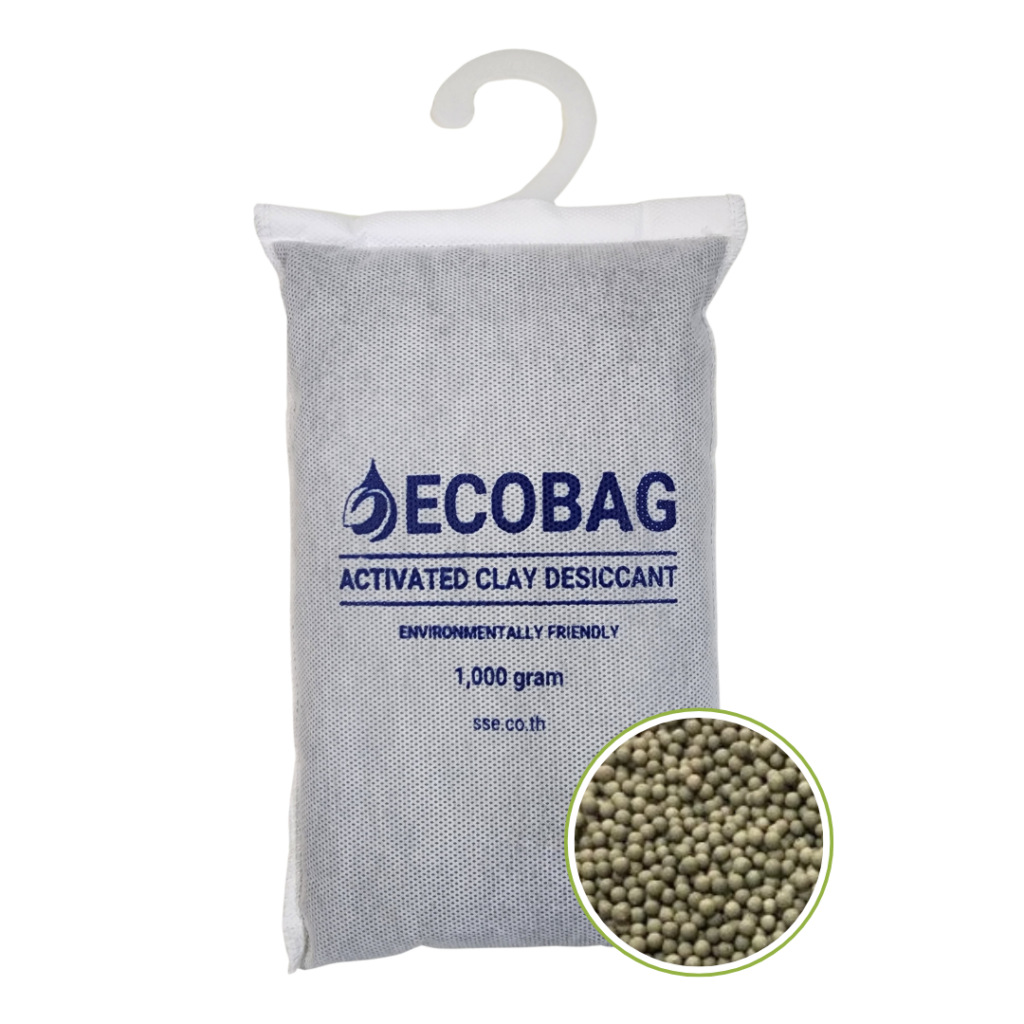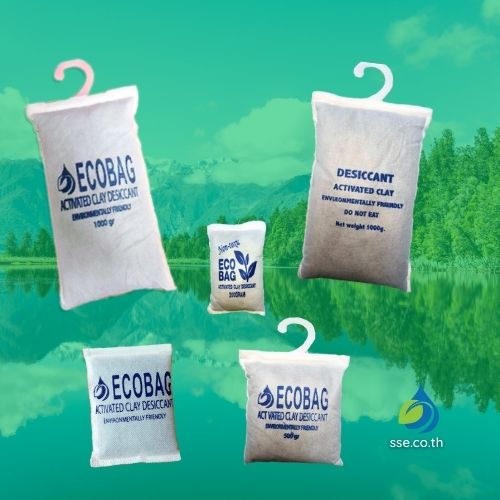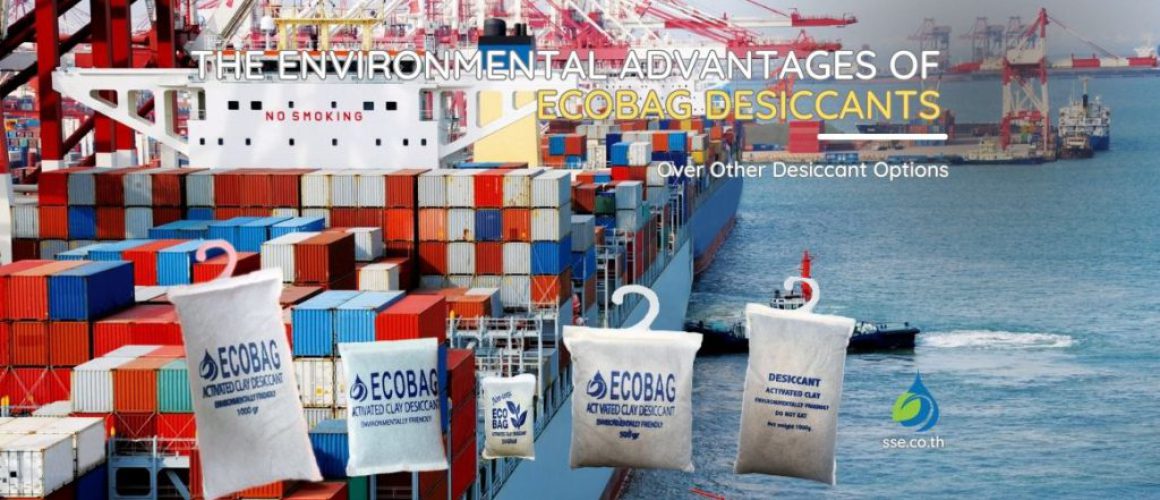The Environmental Advantages of a Natural Desiccant


Table of Contents
What are Desiccants and Why are They Important?
Desiccants play a crucial role in moisture control across various industries. They are substances that absorb and hold water vapor, helping to maintain a dry environment for sensitive products. Effective moisture control can significantly improve product quality, reduce waste, and extend shelf life.
Introducing Ecobag Natural Desiccants: A Sustainable Solution


Ecobag – สารดูดความชื้นที่ทำจากดิน 1,000 กรัม ป้องกันความชื้นในตู้สินค้าอย่างมีประสิทธิภาพ
Desiccant made from clay, Grade A, size 1Kg, with hanging hook (18 pieces per box)
.
Ecobag natural desiccants are an eco-friendly option for moisture control. Made from activated clay, they are biodegradable and boast a smaller environmental impact compared to other common desiccants like silica gel, calcium chloride, and molecular sieves.
Activated clay, a popular desiccant choice, stands out for its eco-friendliness compared to other desiccants like silica gel and calcium chloride. Derived from natural and abundant sources such as bentonite clay, activated clay has a smaller environmental footprint, thanks to its sustainable production process. Furthermore, it is biodegradable, which means that, when disposed of properly, it decomposes naturally and causes minimal harm to the environment.
Ecobag natural desiccants come in various sizes, such as 200g, 500g, 1kg, and 2kg bags, making them suitable for a wide range of applications.
The 200g Ecobag desiccant is ideal for smaller applications, such as protecting personal items in storage boxes or safeguarding electronic devices during transportation. These smaller bags are also suitable for use in camera bags, musical instrument cases, or small cabinets where moisture-sensitive items are stored.
500g Ecobag Natural Desiccant
The 500g Ecobag desiccant is suitable for medium-sized applications. They are often used to protect items in larger storage containers, such as plastic totes, or to control humidity in small- to medium-sized closets, pantries, or storage rooms. This size is also a popular choice for use in IT server rooms or small electronics workshops.
1kg Ecobag Natural Desiccant
The 1kg Ecobag desiccant is perfect for larger applications, such as maintaining optimal humidity levels in shipping containers during transportation or in larger storage rooms and warehouses. This size is also suitable for use in larger IT server rooms or electronics workshops, where moisture control is essential to protect sensitive equipment from damage.
2kg Ecobag Natural Desiccant
The 2kg Ecobag desiccant is designed for the most demanding applications, providing maximum moisture control in the largest spaces or most challenging environments. These desiccants are commonly used in industrial settings, such as large warehouses, shipping containers with high moisture exposure, and manufacturing facilities where controlling humidity is crucial to maintaining product quality and equipment integrity.


Composition and Sustainability of Ecobag Desiccants
Ecobag desiccants are composed of natural clay minerals, which are abundant and renewable resources. Their manufacturing process is more energy-efficient and environmentally friendly compared to the production of synthetic desiccants. Additionally, the biodegradable nature of Ecobag desiccants allows for proper disposal with minimal environmental harm.
By choosing activated clay, you’re not only opting for an effective moisture control solution but also making a responsible choice for the environment.
Innovative and Sustainable Manufacturing Practices
Ecobag natural desiccants are produced using innovative methods and technologies that minimize their environmental impact. For instance, they are manufactured through an energy-efficient drying process that reduces greenhouse gas emissions. These sustainable practices contribute to the overall eco-friendliness of Ecobag desiccants.
In-depth Comparison of Ecobag Natural Desiccants with Other Common Desiccants
In this section, we will provide a detailed comparison between Ecobag desiccants and other common desiccants, namely Calcium Chloride desiccant, Silica Gel, and Molecular Sieve. To help you better understand the differences, we will include tables and visual aids where possible.
Absorption Rates
| Desiccant Type | Absorption Rate |
| Ecobag Desiccant | 40-60% |
| Calcium Chloride Desiccant | 200-300% |
| Silica Gel | 30-40% |
| Molecular Sieve | 20-30% |
Ecobag natural desiccants have an absorption rate between 40-60%, which makes them a competitive option for moisture absorption. Calcium Chloride desiccant, a mixture of calcium chloride, activated clay, and tapioca, boasts a very high absorption rate of 200-300%. Silica Gel has an absorption rate of 30-40%, while Molecular Sieve’s absorption rate ranges between 20-30%.
Moisture Retention and Duration of Effectiveness
Ecobag desiccants not only have a decent absorption rate but also excel at moisture retention, ensuring that the absorbed moisture is not released back into the surrounding environment. Calcium Chloride desiccants also have excellent moisture retention capabilities and a high duration of effectiveness. Silica Gel, on the other hand, absorbs moisture quickly but reaches its full capacity rapidly, making it less effective for extended periods. Molecular Sieves can retain moisture effectively but may require reactivation for long-term use.
| Desiccant Type | Duration of Effectiveness |
| Ecobag Desiccant | Long |
| Calcium Chloride Desiccant | Long |
| Silica Gel | Short |
| Molecular Sieve | Medium |
Ecobag desiccants and Calcium Chloride desiccants both offer a long duration of effectiveness, ensuring continuous moisture absorption throughout extended periods. Silica Gel, however, has a short duration of effectiveness due to its rapid absorption to full capacity. Molecular Sieve has a medium duration of effectiveness, as it may require reactivation for prolonged use.
Environmental Impact
Ecobag desiccants are made from natural materials and are biodegradable, making them an environmentally friendly option. Calcium Chloride desiccants, while effective, are not as eco-friendly due to the chemical nature of calcium chloride. Silica Gel is non-toxic and can be reused after reactivation, but it is not biodegradable. Molecular Sieve, being a synthetic material, is also not biodegradable.
Considering the balance between effectiveness and environmental impact, Ecobag desiccants stand out as an excellent choice for various applications. While Calcium Chloride desiccants may offer superior absorption rates, Ecobag desiccants provide a more sustainable and eco-friendly solution without compromising on performance.
Case Studies and Real-world Examples
To further emphasize the effectiveness and environmental benefits of Ecobag desiccants, let’s examine some real-world examples and case studies.
Case Study 1: Shipping Industry
A shipping company faced issues with moisture damage to their cargo, especially during long voyages. They decided to try Ecobag desiccants due to their eco-friendliness and long duration of effectiveness. After using Ecobag desiccants in their containers, they reported significantly reduced instances of moisture damage, ultimately leading to decreased losses and increased customer satisfaction.
Case Study 2: Electronics Storage
An electronics manufacturer had been using silica gel desiccants to protect their products from humidity during storage. However, they found that silica gel’s short duration of effectiveness led to the need for frequent replacements. They switched to Ecobag desiccants and noticed not only a decrease in moisture-related issues but also reduced waste, thanks to the longer-lasting effectiveness and biodegradability of Ecobag desiccants.
Case Study 3: Pharmaceutical Industry
A pharmaceutical company was searching for an eco-friendly desiccant solution for their moisture-sensitive products. They chose Ecobag desiccants and found that their products remained protected throughout the supply chain, with no compromise to their commitment to environmental sustainability.
Case Study 4: General Warehouse Storage
A warehouse owner was looking for an environmentally friendly solution to control humidity and protect a variety of stored goods, including textiles, furniture, and appliances. They chose to implement Ecobag desiccants throughout their storage facility. The warehouse owner reported an overall improvement in moisture control, resulting in fewer instances of mold, mildew, and corrosion on stored items. The biodegradable nature of Ecobag desiccants also aligned with the warehouse owner’s commitment to environmental sustainability.
These case studies demonstrate that Ecobag desiccants can be an effective and environmentally responsible choice in various industries, outperforming other desiccant options without compromising on quality or performance.
Regulatory Compliance and Environmental Certifications
Ecobag desiccants meet various regulatory standards and hold environmental certifications, which testify to their eco-friendliness and effectiveness. These include:
- REACH Compliance: Ecobag desiccants comply with the European Union’s Registration, Evaluation, Authorization, and Restriction of Chemicals (REACH) regulation, ensuring they are safe for use and do not pose a threat to human health or the environment.
- RoHS Compliance: The Restriction of Hazardous Substances (RoHS) directive sets limits on the use of hazardous substances in electronic and electrical equipment. Ecobag desiccants meet these requirements, further demonstrating their eco-friendly nature.
Disposal Methods for Ecobag Desiccants
Proper disposal of desiccants is essential to minimize their environmental impact. Since Ecobag desiccants are biodegradable, they can be safely disposed of with minimal harm to the environment. This contrasts with synthetic desiccants like silica gel, which may require special disposal methods to avoid contributing to landfill waste.
Performance without Compromising Eco-friendliness
Ecobag desiccants offer an ideal balance between effectiveness and eco-friendliness. Their high absorption rates, capacities, and performance across various temperatures and humidity levels make them a preferred choice for many industries. Moreover, their biodegradable nature and sustainable manufacturing practices ensure that their use does not harm the environment.
Frequently Asked Questions
What is activated clay used for?
Activated clay is used for various applications such as moisture control, oil purification, and odor absorption. It is a common component in natural desiccants like Ecobag natural desiccants.
How is activated clay made?
Activated clay is made by heating natural clay at high temperatures to increase its porosity and adsorption capabilities.
What is activated clay desiccant?
Activated clay desiccant is a moisture-absorbing substance made from activated clay, used to control humidity and protect products from moisture damage.
Is activated clay the same as activated charcoal?
No, activated clay and activated charcoal are different materials. While both are used for adsorption purposes, activated clay is derived from natural clay, while activated charcoal is made from carbon-rich materials such as wood, coconut shells, or peat.
What’s the difference between silica and clay?
Silica gel is a synthetic desiccant made from silicon dioxide, while activated clay is a natural desiccant derived from clay minerals. Both have moisture-absorbing properties, but they differ in their absorption rates, reusability, and eco-friendliness.
What is the difference between desiccant and silica gel?
A desiccant is a substance that absorbs moisture, and silica gel is a type of desiccant. There are other desiccants, like activated clay and calcium chloride, which also absorb moisture.
Is activated clay safe?
Yes, activated clay is generally considered safe and non-toxic. Ecobag natural desiccants, made from activated clay, are environmentally friendly and pose minimal risks to health.
Can activated clay desiccant be reused?
In some cases, activated clay desiccant can be reused by heating it to remove absorbed moisture. However, the effectiveness may decrease with each reuse. It is recommended to follow the manufacturer’s guidelines for reusing Ecobag natural desiccants.
Is clay desiccant food safe?
Clay desiccants like Ecobag natural desiccants are generally considered food safe. They are often used in food packaging to control humidity and prevent spoilage.
Is there a natural desiccant?
Yes, activated clay is an example of a natural desiccant. Ecobag natural desiccants are made from activated clay, offering an eco-friendly moisture control solution.
Is rice a good desiccant?
Rice can absorb some moisture, but it is not as effective as other desiccants like silica gel or activated clay. It is not recommended as a long-term solution for moisture control.
Is baking soda a desiccant?
Baking soda has some moisture-absorbing properties but is not as effective as dedicated desiccants like silica gel or activated clay. Its primary use is as an odor absorber rather than a desiccant.
What is a natural alternative to silica gel?
Activated clay, used in Ecobag natural desiccants, is a natural and eco-friendly alternative to silica gel.
Can rice replace silica gel?
Rice is not as effective as silica gel or activated clay desiccants in absorbing moisture. It is not recommended as a reliable alternative for moisture control.
Can I use rice instead of silica gel?
While rice can absorb some moisture, it is not a suitable replacement for silica gel or other dedicated desiccants like activated clay. Its moisture-absorbing capabilities are limited and not as effective for long-term moisture control.
What is the most efficient desiccant?
The efficiency of a desiccant depends on the specific application and requirements. Ecobag natural desiccants, made from activated clay, are an effective and eco-friendly option for many moisture control situations.
Is table salt a good desiccant?
Table salt can absorb moisture, but it is not as effective as other desiccants like silica gel or activated clay. It may also form a slurry when it absorbs water, which can be problematic in some applications.
Which is the most powerful eco-friendly desiccant?
Ecobag natural desiccants, made from activated clay, are a powerful and eco-friendly option for moisture control. They offer a high absorption rate and are biodegradable, making them an environmentally responsible choice.
What is an alternative to silica?
Activated clay, used in Ecobag natural desiccants, is an excellent alternative to silica gel. It is an eco-friendly and effective solution for moisture control in various applications.
Conclusion
Ecobag desiccants offer numerous environmental advantages over other desiccant options. Their eco-friendly composition, sustainable production process, and biodegradable nature make them an ideal choice for businesses looking to minimize their environmental impact while maintaining effective moisture control. With their excellent performance in various industries, Ecobag desiccants prove that being eco-friendly does not mean sacrificing efficiency or reliability.
Read more
รีวิว 5 ดาว: สารดูดความชื้นที่ทำจากดิน – วิธีการควบคุมความชื้นที่ยอดเยี่ยมสำหรับบ้าน
สารดูดความชื้นที่ทำจากดิน: ทางเลือกที่เป็นมิตรกับสิ่งแวดล้อม
Natural Humidity Control: The Benefits of Eco-Friendly Moisture Absorbers
External links
https://www.allthescience.org/what-is-activated-clay.htm
ขอบคุณที่ใช้เวลาอ่านบทความของเราเกี่ยวกับการป้องกันความชื้น ทางเราหวังว่าท่านจะได้รับข้อมูลที่มีคุณค่าและเป็นประโยชน์ ทางเรายินดีให้บริการการปรึกษาฟรีเพื่อพูดคุยเกี่ยวกับความต้องการของท่านและให้คำแนะนำเกี่ยวกับวิธีการป้องกันความชื้นที่กำหนดเฉพาะสำหรับคุณ โปรดติดต่อเราที่ 0858124188 เพื่อนัดหมายการปรึกษาหรือเยี่ยมชมร้านค้าของเราเพื่อค้นหาผลิตภัณฑ์ที่ช่วยป้องกันสินค้าของคุณจากความเสียหายจากความชื้น ทางเราหวังว่าจะได้รับข่าวสารจากท่านเร็วๆนี้
